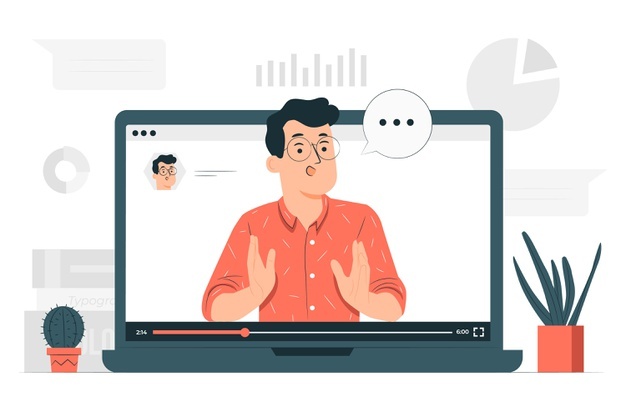Hey, guys! Have you ever wondered how to be a YouTuber? Find out how to create a YouTube account, become a vlogger, and make money on YouTube by uploading video content.
What is YouTube?
YouTube is a video-sharing website and social media platform. Content creators from vloggers to musicians, and news outlets upload videos to be watched by millions. In fact, it’s estimated that there’ll be 1.86 billion online video platform viewers from around the world in 2021.
Launched in 2005, YouTube was bought by Google for $1.65 billion in 2006. And is currently the second most-visited website after Google. The term ‘YouTube’ had an average of 45.5 million searches in the UK over the last 12 months. Globally, there have been 1.3 billion searches. It’s kind of a big deal. And it means that there are a lot of eyes ready to watch your content.
YouTube UK
YouTube is big news in the UK. According to a 2020 study, 97% of British YouTube users used the app at least once a month. That’s a huge amount of active users. And means there’s a lot of potential for your content to be seen.
Let’s take a closer look at the impact of YouTube on the UK economy. According to a 2019 study conducted by Oxford Economics, YouTube’s creative ecosystem supported 30,000 ‘Full Time Equivalent’ (FTE) jobs in the UK. The research also found that the total contribution of YouTube’s creative ecosystem to the UK’s GDP was £1.4B.
Being a YouTuber UK gives you the freedom to work on your terms. Fit content creation into your life and build something to be proud of. 81% of UK creative entrepreneurs agreed that YouTube gives them the opportunity to work in a way that suits their needs.
So how do you become a YouTuber?
How to be a YouTuber
How to create a YouTube account
Visit YouTube and sign up to open a YouTube account. You can use your Google account details to do this and sync your settings. Once you’ve created a YouTube account, it’s time to ‘Start a channel’. If you’re using a desktop, you’ll find this in the menu when you click on your profile image in the top right hand corner.
Your YouTube channel
Once you have your YouTube channel set up, it’s time to head over to YouTube Studio to get started. YouTube Studio is the Creator’s hub. It’s home to your Dashboard where you can upload videos and view analytics associated with your channel. See a summary of monthly views or discover which of your videos are performing the best.
Content strategy
However, before you start uploading content, it’s worth thinking about a content strategy. This doesn’t just mean in terms of a schedule. Instead, a strategy can help you focus the ideas you already have, as well as helping you generate new ones. A good YouTube content strategy will include things like:
- Filming days
- The time and frequency you’ll upload videos
- SEO (optimising your content for searches)
- Collaborations
- How you’re going to promote or market your content.
This is also where you need to look at current trends and what’s going viral. While it’s difficult to predict what will go viral, you can kind of piggyback without copying. For example, searches for videos about ‘distance learning’ took off in 2020 and the #WithMe trend continues to grow in popularity.
Making content
Once you’ve thought about the type of videos you want to produce, it’s time to think about actually making them. First of all, you need to come up with ideas or topics to cover. Think about having a purpose for each video, rather than producing them for the sake of it. Quality over quantity, as the saying goes.
You also need to think about how you want to look to (potential) viewers. Build a strong brand through visuals, delivery, style, aesthetics, etc. Being consistent will make it easier for you to exist across various social platforms, attract an audience, as well as letting them know what to expect.
This can stretch into the type of equipment you use. For example, if you shoot the majority of content on a tripod-stabilised camera, a shakey, handheld video may stand out for the wrong reasons. You don’t have to buy loads of kit in the beginning, but it is worth having a plan. Are you keeping things simple or going for a full studio setup? The amount of equipment you use to make videos is really up to you, but if you want to use more than a smartphone, you need to think about cameras, lighting, microphones, and other accessories.
On top of this, you’ll need editing software, knowhow, and a little time. There are lots of options out there when it comes to video editing software. And they range in features, ease of use, price, etc. However none of these are as easy as using the betting calculators we have on site. Here are some examples to check out.
YouTube’s Video Editor
YouTube has its own video editor, which you will find in YouTube Studio. It’s quite basic in comparison to other software, but it could get you started on becoming a YouTuber. YouTube’s video editor lets you do things like trim unwanted bits of your film and add or edit end screens.
Adobe Premiere Rush
This is the mobile version of Adobe Premier Pro and can be used on videos filmed on your smartphone. In theory, it eliminates the need for a camera and laptop in the creation and editing of your videos. You can also quickly optimise and share your content on social media.
Adobe Spark Video
More software from the Adobe family. Web-based Spark claims to have everything you need to create a YouTube video. And it’s free to use.
DaVinci Resolve
“It’s like having your own post production studio in a single app” claims DaVinci Resolve’s website. This software gives you everything you need to make high-quality video content. However, it’s simple enough for beginners to use.
Pinnacle Studio
With three packages available (Standard, Plus, Ultimate), there’s something for everyone, regardless of needs. Even with the Standard version, you can edit in HD quality, have 6 video and audio tracks, and up to 2 cameras with multi-camera editing.
Shotcut
Shotcut is a free and open source video editor. You can add effects such as filters and transitions and edit both audio and visual elements.
Optimise your YouTube channel
Instead of relying on going viral, you’ll need to optimise your YouTube channel to attract viewers. Create an optimisation strategy to make your videos as easy to find as possible. Here are a few top tips for ways to optimise your individual videos and YouTube channel:
Keywords are one of the most important elements of SEO. Conduct keyword research on a site like Semrush, Moz, or ahrefs and then use relevant long tail keywords in your videos’ titles and descriptions. Think of your video like a blog post and the video description like a meta description. Length of copy and keyword content is important to both your title and description. Some video creators suggest writing at least 250 words and including transcriptions and relevant links to further content.
Use tags, hashtags, and YouTube categories to make sure that your videos are easier to find. And found by potential viewers who are more likely to interact with your content.
Make sure your videos have accurate closed captions to ensure full accessibility to D/deaf viewers. As well as catering to a wider audience, the inclusion of closed captions will help your videos rank higher because search engines can crawl the text.
Add in calls-to-action to guide viewers to further content. Make sure this is done organically. Don’t force them to something that isn’t relevant to the original content they came to you for because this could damage their engagement levels. Use the end screens of your video to introduce calls-to-action.
In terms of optimising your Channel, organise your videos into playlists. This will create a better user experience and could also encourage viewers to watch more of your content. Which is great for your engagement stats. The more engagement you get, the more successful you’ll be as a YouTuber.
How to be a YouTuber: side hustle or full time job?
Whether you dream of becoming a full-time YouTuber, or you just want to earn some extra money, we all have to start at the beginning. Don’t quit your day job if you have 10 YouTube subscribers. You have to grow an audience first. Build up your YouTube presence consistently over time. Not everyone will achieve the heights of Zoe Sugg or MrBeast but why not give being a YouTuber a go anyway?
Vlogging started off as a form of video journaling; of self-documentary. However, as we’ve seen in this article, you can now monetise your YouTube channel. Building a brand and a business is a way to formalise the act of being a vlogger. If you think about it, ‘Influencers’ are professional vloggers. They’re paid to talk about their experiences. If you prefer another avenue to potentially become an influencer, you could potentially check out how to become an Instagram influencer, as this is one of the largest alternative social media platforms.
How to make money on YouTube UK
There are lots of ways to make money on YouTube UK or in any country around the world. Here are some of the ways you can monetise your YouTube account.
Advertising revenue
Advertising is one of the main ways to make money on YouTube. First of all though, you need to apply for and be accepted onto the YouTube Partner Programme (YPP). Being a YouTube Partner means you can boost your earning potential and receive a share of the revenue from any ads that are served on your content.
Minimum criteria for joining YouTube Partner Programme
- Live in a country or region where the YPP is available.
- Follow YouTube’s policies on channel monetisation
- No active Community Guidelines strikes on your channel.
- Have more than 4,000 valid public watch hours in the last 12 months.
- Have more than 1,000 subscribers.
- Link a Google AdSense account to your YouTube account.
Once you’ve hit the above criteria for eligibility, your channel will automatically be put in a review queue. If your application is accepted, you can set up ad preferences and enable monetisation on your uploads straightaway.
Google AdSense
AdSense allows for smarter advertising. Choose which ads you think fit your audience best. This creates a less-jarring experience for the viewer and encourages more engagement, in theory. The payment you receive from Google depends on the type of ad displayed and the number of impressions and clicks.
Affiliate or influencer marketing
There are subtle differences between affiliate marketing and influencer marketing, but ultimately they involve promoting a product or service in exchange for money. Often, you share a link or discount code with viewers. If someone buys the product or service promoted in your video after clicking your link, then you will receive a commission. Read our article to find out more about affiliate marketing.
Sponsored videos and collaborations
Following on from the above point, sponsored videos are usually created in connection with a brand. Collaborations between YouTubers and brands happen a lot. And they usually happen when your content is attracting viewers. If your Channel is gaining traction, you’re likely to catch the attention of a brand or two.
The more viewers you have watching each video you upload, the more your videos are worth. Brands are willing to pay to be seen by a lot of people. With sponsored videos, the sponsor (brand) will pay you an agreed amount of money to advertise them in some way. How you advertise will depend on the agreement or terms of the sponsorship. For example, you could mention the product or service in your introduction or deliver a full review.
Another form of collaboration is between YouTubers. Whilst this won’t make money in the same way as a sponsorship deal, it could help you grow your numbers which in turn should widen your earning potential.
As always, make sure that any promotional or sponsored content follows UK advertising guidelines.
Channel memberships
Channel memberships can be offered to viewers in order to encourage repeat engagement and recurring income. In return for their monthly support, you offer member-only perks, such as exclusive content. This is something you can start to introduce as your viewership grows. In fact, to be eligible to offer channel memberships, you need to be a member of the YPP and have at least 1000 subscribers.
As long as the perks comply with YouTube’s community guidelines, you can offer lots of exclusive content. Ideas include early access to videos, exclusive live streams, or behind-the-scenes content or contact. You could also offer physical goods such as stickers, clothing, or discount codes for your other merchandise.
Merchandise (merch shelf)
Branded merchandise is a great way to make money on YouTube. It can earn you a passive income alongside other monetisation avenues, or it can be your main revenue stream. To be eligible to sell via YouTube’s merch shelf, you must be a member of YPP and have more than 10,000 subscribers. However, if you wish to go down another route when it comes to creating merch, you may want to check out how to sell on Etsy.
If you do choose to sell merch on YouTube, you’ll need to think about things like design, pricing, and logistics. Take the time to understand what will appeal to your audience and test the waters. For example, you could release something on a limited run to see how well it sells. Make sure that anything you do want to sell complies with YouTube’s policies.
Donations
This point is a little different to the monetisation options we’ve just talked about because it’s not on YouTube. However, it’s a similar approach to Channel membership but using a site like Patreon. You may be asking: “What is Patreon?”. Simply put, this is a membership platform where Creators share exclusive content with monthly subscribers. If you’re working towards 1000 YouTube subscribers in order to be eligible for their Channel membership you could test the waters with an offsite subscription platform first. Click the link to find out more about Patreon and how you could use it to make money as a YouTuber.
Before any of this though, you need an audience. You’ll struggle to make money if there’s no one watching your videos. You could increase your following directly on YouTube through consistent posting, marketing, and engagement. However, if you already have a following on another social platform, you can invite them across. An audience is an audience and if they’re interested in your brand and content, they’ll want to watch. Build it and they will come.
Building a YouTube audience
Building a YouTube audience is a fundamental part of monetising your YouTube channel. While there’s no surefire way to attract viewers, some of the optimisation tips earlier in this article should help. There are also some techniques you can use in order to connect with YouTube users, according to the YouTube Culture and Trends Report 2021. Let’s take a quick look at some of the key ways to connect with viewers, according to the report:
Immediacy
Immediacy is a way for people to connect in real time. YouTube now offers the option to live stream, similarly to Instagram, Facebook, and other social platforms. In 2020, over half a million channels live streamed for the first time in 2020. Obviously the COVID-19 situation played a large part in how video has performed over the last year, but some of the trends are continuing. 85% of people globally and 78% of Brits watched a live stream over the past year. If livestreaming is more of your forte, then you may even want to check out how to make money on Twitch, as this is arguably the largest streaming platform.
Relatability
What do people want to watch? Well perhaps surprisingly, it doesn’t have to be something spectacular. Content that people can relate to is a great way for them to connect with you and your channel. Again, thanks in part to the pandemic, the mundane has grown in popularity. With lockdown, working from home, and the increase in video conferencing, there was a breakdown between our public and private lives. For example, we got to see what a lot of celebrities get up to at home. We even saw Joan Collins washing her windows…it doesn’t get much more mundane and relatable than that.
Immersiveness
Joint experiences became virtual as we all kept our distance socially, throughout the pandemic. We began to crave being at gigs, football games, or festivals. We missed being ‘in the moment’. Perhaps this contributed to a rise in the popularity of immersive content. For example, 51% of YouTube UK viewers watched filmed podcasts over the last 12 months. It feels like we’re being given exclusive access to something we wouldn’t normally be part of.
Think about how you can use immediacy, relatability, and immersiveness in your content to connect with viewers and grow your audience.
How much do YouTubers make?
The amount of money YouTubers make depends on a number of things. For example, how many revenue streams are they operating? What kinds of sponsorship deals do they have? How long have they been running a YouTube channel? It also depends on how much time and attention they dedicate to producing content for YouTube.
There’s a large variation of earning potential as a YouTuber. According to the job review site Glassdoor, the average reported salary for a YouTuber in the UK is £31,595. The highest reported salary is £61,676 and the lowest reported salary is £16,186 per year.
Factors that can affect the amount of money you could make on YouTube include:
- CPM vs CPC (Cost Per Click vs Cost Per Mille (or thousand impressions).)
- Estimated earnings per Subscriber
- Estimated gross earnings per 1,000 Views
- Est. variance based on engagement
As long as you consistently post good quality content, building your audience, and introduce revenue streams that work for your channel, you can make money vlogging. And whilst the estimated earnings of some YouTubers may be a little out of reach, isn’t it fun to dream…?
Top earners on YouTube
Forbes published a list of 2020’s highest-paid YouTubers based on estimated earnings between June 1 2019 to June 1 2020. Following a number of other caveats which you can find in the original article, they also defined a ‘YouTuber’ as “someone whose primary form of digital and media revenue comes from YouTube”.Here are the top 10 earners from Forbes’ research. However, these are professional video content creators. This isn’t just one of their side hustle ideas. And it’s worth noting that these aren’t all one-man band operations. For example, there’s a team of 30 employees behind Ryan’s World. The channel has evolved from toy reviews to a kid’s entertainment brand, with writers, videographers, and animators churning out up to 25 videos a week.
| # | Channel | Earnings ($) | Subscribers | Views | Run by |
| 1 | Ryan’s World | $29.5 million | 41.7 million | 12.2 billion | Ryan Kanji |
| 2 | Mr Beast | $24 million | 47.8 million | 3 billion | Jimmy Donaldson |
| 3 | Dude Perfect | $23 million | 57.5 million | 2.77 billion | Coby Cotton, Cory Cotton, Garret Hilbert, Cody Jones and Tyler Toney |
| 4 | Good Mythical Morning | $20 million | 41.8 million | 1.9 billion | Rhett and Link |
| 5 | Markiplier | $19.5 million | 27.8 million | 3.1 billion | Mark Fischbach |
| 6 | Preston | $19 million | 33.4 million | 3.3 billion | Preston Arsement |
| 7 | Nastya | $18.5 million | 190.6 million | 39 billion | Anastasia Radzinskaya |
| 8 | Blippi | $17 million | 27.4 million | 8.2 billion | Stevin John |
| 9 | David Dobrik | $15.5 million | 18 million | 2.7 billion | David Dobrik |
| 10 | jeffreestar | $15 million | 16.9 million | 600 million | Jeffree Star |
Other ways to make money online
At Odds Monkey, you can visit our Make Money Online hub for more ideas on how to make money online. Matched betting is a clever technique which allows you to turn free promotional bets offered by bookmakers into real profit. Check out our ‘What is matched betting?’ guide to find out more.






